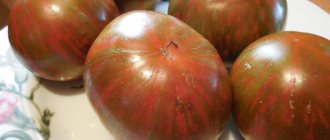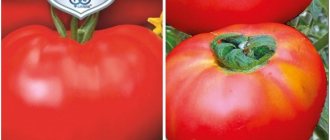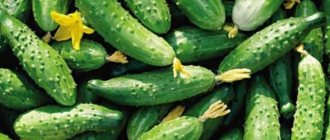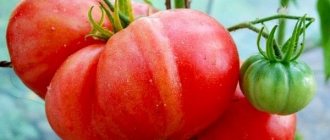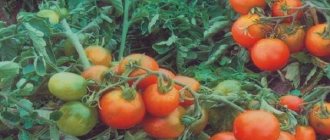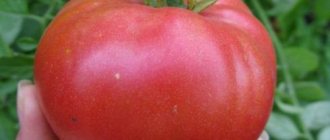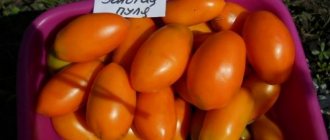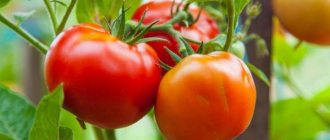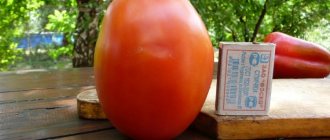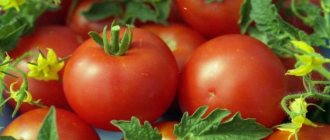Leningrad giant is an unusual tomato, because its bushes are compact in size and its fruits are very large. This rarely happens. But this feature does not harm the taste of tomatoes - on the contrary, their flesh is juicy, sweet and very tasty.
| Height | Landing location | Ripening time | Fruit color | Fruit size | Origin | Fruit shape |
| short | Greenhouse, Open ground | Early ripening | Pink | Large | Variety | Flat-round |
Description and characteristics of the variety
The Leningrad Giant tomato variety is determinate. The bush grows up to 90 cm, semi-spreading, slightly leafy. The first inflorescence appears over 7-9 leaves, then they are formed every 1-2 leaves. The harvest can be harvested within 85-90 days after germination. The tomatoes are large, weigh up to 300 g, flat-round in shape and slightly ribbed. Their color at ripeness is pink and the stalk has a dark spot. The pulp contains a lot of juice, is fleshy, and has a sweet taste.
Tomatoes are used for salads, lecho, juices and sauces, and can also be preserved by cutting them into pieces.
Tall tomatoes for the greenhouse
I definitely plant the listed varieties, but there are also some that I just liked, and I periodically grow them in the greenhouse, but I have not become a fan of them. Of the indeterminates, I like the raceme varieties the most. Again, this is primarily because they look beautiful on the bush. There are only three varieties, and each has a special reason to grow it.
Read also: Prepare delicious mustard at home
“Intuition F1” is a mid-season hybrid, but I would classify it as a late-season hybrid. Not only does it reach harvest ripeness only by mid-August, but biological maturity also comes quite late. Some specimens of these tomatoes ripen even until the end of October. But, on the other hand, this is convenient because as a result, we have our own fresh tomatoes at home for a very long time. That's why I sow it in February.
Rice. 12. Photo from the end of July, but the fruits have not yet begun to ripen.
But “Intuition F1” is very easy. This hybrid is great for freezing for future use. In winter, I make pizza and frittata with them, as they do not defrost like porridge, but retain their meatiness well when cut.
Rice. 13. The fruits are all smooth and beautiful.
Rice. 14. In this form, I send “Intuition F1” to deep freeze.
“Scarlet Candles” is a cluster variety, mid-season. They don’t have a special taste, but what a shape! Looks impressive in preparations with cucumbers. However, this is why I grow them. It’s nice to admire such a jar later in the winter.
Rice. 15. The length of “Scarlet Candles” is almost like pickling cucumbers.
Rice. 16. “Scarlet candles” look neat, they all have a characteristic “spout”.
“De Barao” is quite late-ripening; I sow it earlier than the bulk of tomatoes. I really like it in preparations, it does not crack and is very tasty, both fresh and pickled.
Rice. 17. "De Barao" is resistant to disease. I always plant it on the north side, tying it above the entrance to the greenhouse, because it is very tall, and the upper tier ripens even in the last ten days of August, despite the first cold nights.
Rice. 18. The fruits are beautiful, all as one.
I have tried a great variety of salad varieties, I still want to find the most delicious one. Of the unusually colored tomatoes, I really like the taste of Malachite Box and Black Prince . Both are tall and require pinching, gartering, and formation into 1-2 stems, but the effort is worth it, the fruits are magnificent. “Black Prince” is dark burgundy when fully ripe.
Rice. 19. “Malachite box” in biological maturity – green.
Rice. 20. All these “Malachite Box” tomatoes are already ripe, although in appearance they seem unripe.
The yellow giants are not inferior in taste, of which the most fleshy and tasty for me are “Yellow Truffle” - of an unusual shape, “Persimmon” - indeed, the pulp is cut like the fruit of the same name, “Golden King” and sweet as a melon, “ Golden Bull" . “Golden Heart” and “Altai Yellow” were less impressive But it should be noted that the shelf life of yellow tomatoes is inferior to red ones. From salad reds, I grew “King of Large”, “Cardinal”, “Canary”, “Bear’s Paw”, “Mazarin”, “Altai Red” . What can I say about them - they are all equal, as if they were selected. It tires them to constantly tug and tie them up. One good thing is that they are large.
Rice. 21. Everyone looks the same on the bush. This is Cardinal.
Rice. 22. “Cardinal” is well kept.
Rice. 24. In the foreground is “Mazarin”. It differs only in shape, in taste - like all other red-fruited ones.
Rice. 25. “Altai Reds”, however, can be praised for their friendly maturation.
Separately, I would like to mention the pink-fruited tomatoes “Miracle of the Earth”. If you are lucky with the summer and it is not very hot, then you can get a good harvest from this variety.
Read also: Forged patterns for gates photo
Rice. 26. “Miracle of the Earth” are also tall.
But, if there is not very good ventilation in the greenhouse, then this variety will give a characteristic light yellow border, I don’t like it, and I cut it off before use.
Rice. 27. “Miracle of the Earth” - on the right. They are the same size as the Red Giant on the left.
Separately, it should be said about tall cherry tomatoes, for example, “Chio-chio-san”, “Sweet Cherry F1” and others. Yes, many of them are sweet, they look elegant both in the greenhouse and in pickles, but many of them are thrown away and require careful care. No matter how much I refuse to plant them, I still “break down”, I really want to admire the brushes.
Rice. 28. “Red date” is, of course, delicious.
Rice. 29. “Goldilocks” also tastes good if you resist and don’t eat it half-ripe - and it can be eaten even half-ripe.
Disease control, preventive measures
Every vegetable grower must know what diseases can appear in tomatoes of this variety, and how to identify them based on the symptoms. If you treat the seeds with mercuric chloride and disinfect the soil in greenhouses, this will protect the plant from bacterial growth.
Plant diseases are often associated with leaf damage:
- No, no, and tomatoes are deficient in phosphorus in the soil or moisture in the air; on top of the bush you can see rough leaves twisted into a tube. It is not yet possible to remove the seeds from this diseased plant for further cultivation.
- If the plant has become ill with an infectious disease, then you may notice silver-white spots on the surface of the leaves. What to do is prepare a solution of Bordeaux mixture and spray the plant with it, and over time repeat this procedure 2 more times after 10 days.
- Red-brown stripes appearing on the leaf blades and stems can alert you to the fact that the plant is infected with streak. The bush begins to show weak growth, the leaves begin to dry out and curl. Plant diseases are caused by infected moura. Before you start sowing, you need to carefully select the mora, prepare a weak solution of potassium permanganate and pickle them in it (this will take about 20 minutes).
- Plants can also be attacked by various types of microorganisms, such as pathogenic ones. What will the pattern on the leaves in the form of a mosaic indicate? Control methods are the same as for strik infection.
Leningrad giant tomatoes often exhibit symptoms of many diseases that every gardener should know about.
Signs of damage to tomatoes appear: browning of blood vessels on the cut of the stem; on still green tomatoes - small round spots with a crack in the middle. The disease progresses rapidly, leading to loss of large tomato yields.
Many diseases of varietal tomatoes are associated with leaf damage:
- If the leaf plate of a vegetable plant curls into a tube and becomes rough, then the tomatoes do not have enough phosphorus in the soil or moisture in the air. Leaf curl is genetically transmitted, so you cannot take seeds from a diseased crop for subsequent growing of tomatoes.
- Many silvery-white spots on the surface of tomato leaves indicate the development of an infectious disease. When the first signs appear, it is necessary to spray the bushes with a solution of Bordeaux mixture. Repeat this procedure twice more after ten days.
- Red-brown stripes that appear on the leaves and stems of tomatoes signal a streak infection. The plant looks sick and is stunted. And its leaves curl and dry out. The cause of tomato disease lies in the affected seeds. Before sowing, they should be strictly selected by treating the seed material in a weak solution of potassium permanganate for twenty minutes.
- The mosaic pattern on tomato leaves is associated with infection by pathogenic microorganisms through plant sap. You need to deal with tomato mosaic in the same way as with streak.
Pathologies of tomatoes can be prevented by preventative treatment of bushes with Bordeaux mixture three times with a break of ten days.
Agricultural technology for vegetable crops in greenhouses
To get a harvest of pink fruits early, Leningrad Giant tomatoes are sown in prepared greenhouses from March 25 to early April.
Eight to ten days before this, the greenhouse recesses are filled with hot manure. If the biomaterial is compacted in the middle, along the walls, then in other places it is laid loosely. The settled manure is leveled after four days. After this, the soil is poured in a layer of fifteen to seventeen centimeters. You can plant tomato seeds for seedlings in such a greenhouse when the soil temperature reaches 25 degrees above zero.
To place Leningrad giant tomato seedlings under cover from pots, diving them, outline the lines of future rows. The tomato planting pattern is 70x40 centimeters. Before transplanting tomato seedlings, a third of their roots are removed. This procedure promotes enhanced development of the root system of the tomato variety. Although some gardeners consider this unnecessary.
Transplanted tomato seedlings are carefully looked after:
- At first, water at the root once every five days, then, in May, daily. They don’t skimp on water, a bucket per square meter of tomato plantings.
- A week later, young tomato bushes are fed with mullein solution in a ratio of 1:8. A good effect will be from feeding tomatoes with ammonium nitrate, taken in the amount of fifty grams per bucket of water.
- If the tomato stems begin to turn purple, this indicates a lack of phosphorus. Add a solution of wood ash to the soil, diluting 75 grams of raw material in ten liters of water.
- On sunny days, the film covering from tomato seedlings can be removed for ventilation.
- Seedlings are hardened off two weeks before planting in open ground. First, open the greenhouse for two to three hours, then increase the time to seven to eight hours. It is advisable to reduce watering of young bushes at the end of cultivation, and moisten them generously before planting in garden beds.
Caring for giant tomatoes in open ground is common, as for other types of vegetable plants.
Reviews
- Nikolai Azimov, 53 years old:
I have been growing different varieties of tomatoes for a long time. I like the Leningradsky early ripening variety for the early production of ripe and tasty tomatoes, as well as for their ease of care. Low-growing bushes tolerate temperature changes well. The fruiting period begins at the end of June and can last until the end of August. - Varvara Mikhailovna, 61 years old:
At the dacha, I always try to plant early-ripening vegetables, because I always want to get fresh vegetables from the garden early. I have been planting the Leningradsky variety every year for about 5 years now. I like its unpretentiousness and compactness. The slightly sour taste of the fruit enhances the taste of any dish. Mostly all the tomatoes were used for fresh consumption and for preparing summer vegetable salads.
tomato Lord - description and characteristics of the variety
Preparations from large tomatoes for the winter
The large fruits of the Leningrad giant are suitable for winter canning recipes such as tomatoes in gelatin. To prepare a tasty product, take only large tomatoes, cutting them into four parts. Together with chopped onions, they are placed in glass jars. Boil the marinade, taking one hundred grams of salt per four liters of water, five hundred grams of sugar, adding peppercorns. The swollen gelatin is poured into the brine and boiled for five minutes. Pour this marinade over chopped tomatoes and seal the jars.
Sliced tomatoes in vegetable oil are delicious. Spices, chopped tomatoes, and onion rings are placed in jars. Everything is poured with the usually prepared marinade. After pasteurization, add vegetable oil in a layer of up to two centimeters.
Read also: How to make sun-dried tomatoes at home
All that remains is to roll up the canned product, then let it cool and place it in a cool place. It keeps for a long time and the tomatoes taste like fresh.
